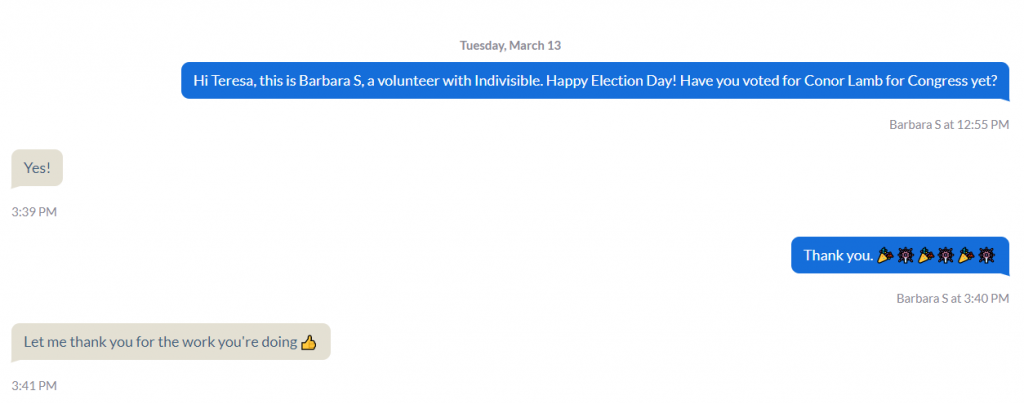Read time: 5 min
Lately, I’ve been feeling really popular. My phone is perpetually blowing up with texts from Segolene, Karen, and Ana, inviting me to rad events, wanting to dish about the latest news, or asking my opinion about a project they’re working on.
Thing is, I’ve never met Segolene, Karen, or Ana. But they’re able to send personal and engaging messages to me (and thousands of others) through the magic of peer-to-peer texting.
Unlike blast SMS programs, peer-to-peer texting allows you to message people who may be interested in your cause but haven’t opted onto your subscriber list. Plus, you can respond to supporters who write back with a personal message, just like a text you’d send from your own phone.
We worked with Indivisible on their peer-to-peer text program for the PA-18 special election in March, working through the kinks and developing some powerful new tactics to reach and inspire potential voters. I’m not quite ready to say this effort was the only reason Conor Lamb won a tough race, but there are some important lessons here that any nonprofit considering P2P texting can benefit from.
Why Bother with Peer-to-Peer?
I know what you’re about to say: That sounds really nice, Gwen, but I’ve already got an email program to manage, 5 social media channels to monitor, ads to launch, turf to cut, doors to knock, phones to bank, and organizers to organize. Why should I bother adding peer-to-peer on top of that?
As Indivisible developed a strategy to help drive votes for Conor Lamb, peer-to-peer was the natural answer:
- It is fast to pull together. In less than a week, we signed a contract for a platform, identified our voter universe and loaded it into the tool, drafted canned messages volunteers could use to communicate with voters, and recruited and trained 300+ volunteers to help us text. We went from zero to hundreds of trained volunteers ready to make thousands of personal voter contacts, in a week’s time!
- It’s cheap. Plans vary but can run you about $0.10/message (a “per message” plan is good if you think there may be a lot of bad numbers on your list) to $0.15/contact for unlimited messages to a contact (pick a “per contact” plan if you think there will be lots of good numbers on your list who will be eager to chat back and forth with your volunteers).
- It put volunteers in the driver’s seat. Volunteer leadership was baked into every aspect of Indivisible’s program in PA-18—from recruiting texters, to staffing the help desk, to of course sending the messages themselves. It allowed Indivisible to be very hands-off in the process and build volunteer leadership muscles they can continue to leverage down the road. Volunteers also loved peer-to-peer because they could do it from anywhere using their phone or the web interface. They loved it SO much, in fact, that we ran out of numbers to text on the first day!
- It’s effective. Mail gets tossed, phone calls get ignored, but 90% of text messages are read within 3 minutes according to Dynmark. And people aren’t just reading your messages, they’re doing something because of them: Analyst Institute found a statistically significant 0.2% increase in turnout (on par with—but a lot cheaper and faster than—canvassing) as a result of get out the vote (GOTV) peer-to-peer text messages.

How to Get Started
If you’ve read this far, you’re either my dad (hi!), or a newly-converted true believer in the power of peer-to-peer (welcome!).
Before you take the plunge, ask yourself these three questions:
- How much is my organization willing to let go? While you’ll draft pre-written messages for volunteers to use while texting, volunteers are going to be out there in the world, talking to people on your behalf. They may go off script. They may say something that’s not-quite-on-brand. If just reading that sentence gives you hives, peer-to-peer might not be best for you.
- Who’s going to run this? The answer to this question is not necessarily staff! In PA-18, Indivisible volunteers staffed our help portal, answering questions for texting newbies. That freed up staff to focus on things like coordinating with partner organizations. We identified some essential roles during the PA-18 campaign:
- desk volunteers who could answer questions from fellow texters
- volunteers to check the data coming in to make sure it’s being tracked properly
- volunteers who can lead training sessions for new texters.
Who in your organization or supporter community can fill those roles for you?
- How much time do I have? Peer-to-peer platforms are relationship-building tools, full stop. Just like you’d never call a donor, ask for $1,000, and then promptly hang up, you shouldn’t plan on sending your peer-to-peer texts and calling it a day. Build in time in your plan—and prep your volunteers—to keep the conversation going. Some of our Indivisible volunteers were getting replies back to their messages 24-48 hours later!
Indivisible won big in PA-18, electing a Democrat to a deep red seat and giving Indivisible supporters (and progressives) everywhere a big boost of momentum heading into the 2018 midterms.
Along the way, they also grew their footprint in the district, gaining hundreds of new supporters they quickly plugged into the nearest Indivisible group. And among our mighty texting team, we identified dozens of new volunteer leaders Indivisible can rely on to establish new groups and lead future texting programs.
All that, in two weekends of peer-to-peer texting. I’d say that’s pretty 💯💯💯.
